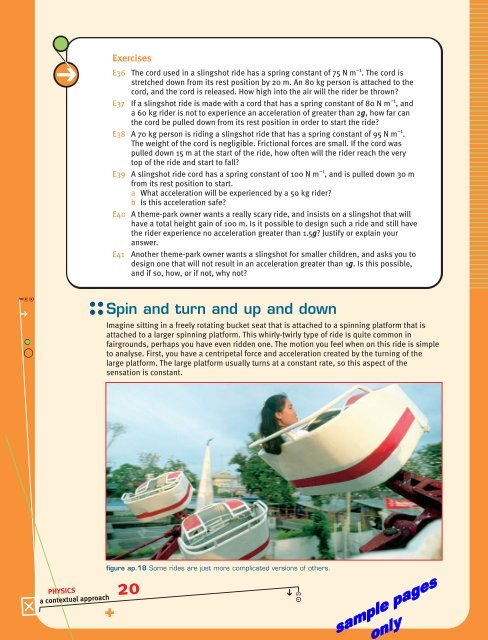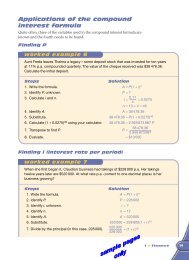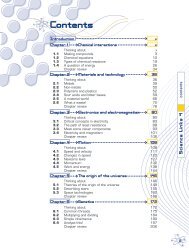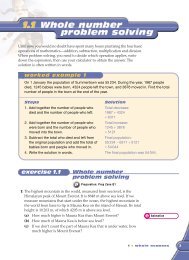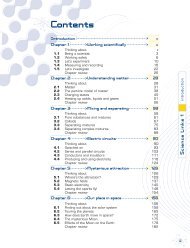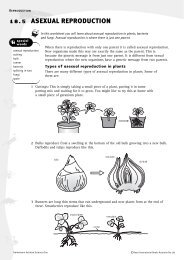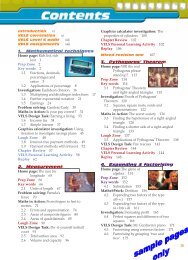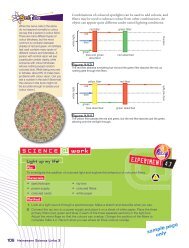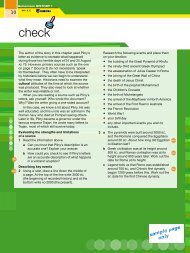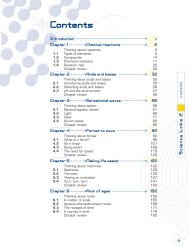Context 1: Amusement Park Physics - hi.com.au
Context 1: Amusement Park Physics - hi.com.au
Context 1: Amusement Park Physics - hi.com.au
You also want an ePaper? Increase the reach of your titles
YUMPU automatically turns print PDFs into web optimized ePapers that Google loves.
⌧<br />
<br />
➔<br />
➔<br />
PHYSICS<br />
a contextual approach<br />
Exercises<br />
E36 The cord used in a slingshot ride has a spring constant of 75 N m –1 . The cord is<br />
stretched down from its rest position by 20 m. An 80 kg person is attached to the<br />
cord, and the cord is released. How <strong>hi</strong>gh into the air will the rider be thrown?<br />
E37 If a slingshot ride is made with a cord that has a spring constant of 80 N m –1 , and<br />
a 60 kg rider is not to experience an acceleration of greater than 2g, how far can<br />
the cord be pulled down from its rest position in order to start the ride?<br />
E38 A 70 kg person is riding a slingshot ride that has a spring constant of 95 N m –1 .<br />
The weight of the cord is negligible. Frictional forces are small. If the cord was<br />
pulled down 15 m at the start of the ride, how often will the rider reach the very<br />
top of the ride and start to fall?<br />
E39 A slingshot ride cord has a spring constant of 100 N m –1 , and is pulled down 30 m<br />
from its rest position to start.<br />
a What acceleration will be experienced by a 50 kg rider?<br />
b Is t<strong>hi</strong>s acceleration safe?<br />
E40 A theme-park owner wants a really scary ride, and insists on a slingshot that will<br />
have a total height gain of 100 m. Is it possible to design such a ride and still have<br />
the rider experience no acceleration greater than 1.5g? Justify or explain your<br />
answer.<br />
E41 Another theme-park owner wants a slingshot for smaller c<strong>hi</strong>ldren, and asks you to<br />
design one that will not result in an acceleration greater than 1g. Is t<strong>hi</strong>s possible,<br />
and if so, how, or if not, why not?<br />
Spin and turn and up and down<br />
Imagine sitting in a freely rotating bucket seat that is attached to a spinning platform that is<br />
attached to a larger spinning platform. T<strong>hi</strong>s w<strong>hi</strong>rly-twirly type of ride is quite <strong>com</strong>mon in<br />
fairgrounds, perhaps you have even ridden one. The motion you feel when on t<strong>hi</strong>s ride is simple<br />
to analyse. First, you have a centripetal force and acceleration created by the turning of the<br />
large platform. The large platform usually turns at a constant rate, so t<strong>hi</strong>s aspect of the<br />
sensation is constant.<br />
figure ap.18 Some rides are just more <strong>com</strong>plicated versions of others.<br />
✚<br />
20<br />
<br />
➔


